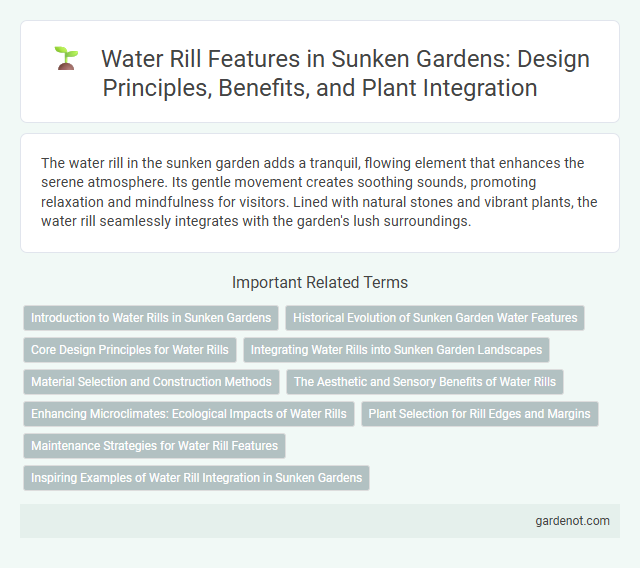The water rill in the sunken garden adds a tranquil, flowing element that enhances the serene atmosphere. Its gentle movement creates soothing sounds, promoting relaxation and mindfulness for visitors. Lined with natural stones and vibrant plants, the water rill seamlessly integrates with the garden's lush surroundings.
Introduction to Water Rills in Sunken Gardens
Water rills in sunken gardens serve as narrow, shallow channels guiding gently flowing water through the landscape, creating serene visual and auditory effects that enhance the garden's tranquility. These water features provide vital irrigation to surrounding plants while maintaining aesthetic harmony with the garden's architecture and natural elements. Their design often incorporates natural stone or brick, blending functionality with the historical and horticultural significance of sunken garden layouts.
Historical Evolution of Sunken Garden Water Features
Sunken garden water features trace their origins to ancient Persian and Moorish designs, where water rills served both aesthetic and practical purposes by cooling the air and directing water flow. During the Renaissance, water rills evolved into intricate channels that enhanced the geometric layout of formal gardens, symbolizing control over nature. Modern sunken gardens often incorporate updated water rills that blend historic elegance with contemporary irrigation technologies, preserving their legacy while improving sustainability.
Core Design Principles for Water Rills
A water rill in a sunken garden emphasizes linear flow and gentle sound, integrating smooth, continuous channels that guide water through natural or geometric pathways. Core design principles include ensuring proper gradient for controlled water movement, selecting materials that enhance reflection and texture, and maintaining harmony with surrounding plantings to create a tranquil, cohesive environment. Attention to scale and proportion guarantees the water rill complements the sunken garden's overall spatial dynamics and aesthetic balance.
Integrating Water Rills into Sunken Garden Landscapes
Water rills enhance sunken garden landscapes by creating dynamic, narrow channels that guide water flow while adding soothing auditory and visual elements. Integrating these rills involves carefully designing gentle slopes and natural stone linings to ensure smooth water movement and prevent erosion. Their presence supports diverse aquatic plants and attracts wildlife, enriching the garden's ecosystem and aesthetic appeal.
Material Selection and Construction Methods
Water rills in sunken gardens are typically constructed using durable materials such as natural stone, cast concrete, or brick to ensure longevity and resistance to water erosion. Selection favors materials with smooth surfaces to facilitate water flow and prevent debris buildup, while construction methods involve precise grading and waterproofing techniques to maintain consistent water levels and prevent leakage. Integrated drainage systems and careful joint sealing are essential to sustain structural integrity and aesthetic appeal over time.
The Aesthetic and Sensory Benefits of Water Rills
Water rills in sunken gardens enhance aesthetic appeal by introducing flowing water elements that create dynamic visual interest and reflection. The gentle sound of running water provides calming sensory benefits, reducing stress and promoting relaxation. These features also help to improve air quality and humidity, contributing to a more pleasant outdoor environment.
Enhancing Microclimates: Ecological Impacts of Water Rills
Water rills in sunken gardens play a crucial role in enhancing microclimates by increasing ambient humidity and cooling surrounding air through evaporative processes. These narrow channels promote biodiversity by creating moist habitats that support a variety of plant species and aquatic invertebrates, contributing to ecological balance. The constant movement of water also aids in air circulation and prevents stagnation, fostering a healthier environment within the garden ecosystem.
Plant Selection for Rill Edges and Margins
Selecting plants for rill edges and margins involves choosing species that thrive in moist, well-drained conditions while stabilizing soil and enhancing aesthetics. Suitable options include moisture-loving perennials like hostas, irises, and ferns, which tolerate occasional water splashes and provide dense, lush foliage. Incorporating native sedges and rushes along the water rill edges helps prevent erosion and supports local biodiversity.
Maintenance Strategies for Water Rill Features
Effective maintenance strategies for water rill features in sunken gardens include regular cleaning to prevent debris buildup and algae growth, ensuring uninterrupted water flow. Routine inspection of pumps and filtration systems helps detect early signs of wear or blockages, minimizing downtime and repair costs. Incorporating water-level monitoring and seasonal adjustments preserves the structural integrity and aesthetic appeal of the water rill year-round.
Inspiring Examples of Water Rill Integration in Sunken Gardens
Water rills in sunken gardens create tranquil water features that enhance the peaceful ambiance while providing visual and auditory appeal. Famous examples such as the Alhambra's Generalife showcase narrow, shallow channels lined with stone that guide flowing water through lush terraces, symbolizing paradise and reflecting Moorish architectural elegance. Integrating water rills in sunken gardens not only improves microclimate by cooling the air but also connects visitors to nature through the soothing sound and movement of water.
Water rill Infographic

 gardenot.com
gardenot.com